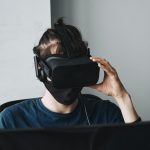VR training should be utilised in every industry, obviously, but did you know VR technology has been used for the military for years now (way before VR was known to be used for just defeating ugly zombies)?
“You have to be ready for what’s coming next, and that’s what the simulated environments we’re trying to create are going to drive us to.”
Says Col. Robert H. Epstein, commander of the Air Force Agency for Modelling and Simulation.
VR technology enables the users to be fully engrossed in scenarios, without the variety of real-life dangers. This makes this technology perfect for the military, as the defence sector can learn a variety of necessary skills and abilities without having to be involved in actual dangerous or fatal environments. VR is employed in all three sections of the military (air force, navy and the army), and these are the ways the technology is effective;
1.
COST EFFECTIVE TRAINING
This technology enables members of the military to partake in a massive variety of simulations without the need for specific environments or a plethora of equipment, hence significantly saving on training budgets.
2.
TRAINING THAT STICKS
Military personnel can utilise VR to experience dangerous tasks, such as parachute jumping, to become familiar with the feeling and overcome the initial disorientation and fear of jumping from an aircraft without the imminent threat of danger. This can also be applied to learning how to fly in fighter jets, operating submarines, tanks or other vehicles in order to become used to the closed spaces and potentially hostile environments. Through this training, prospective soldiers can remain calm in stressful situations because VR training helps immensely with regulating emotions through its immersive nature.
3.
BECOME MORE SITUATIONALLY AWARE
Soldiers, in the field, have to experience new environments frequently and VR can help take away some of the stress and uncertainty that surrounds this. Through the immersive technology, military personnel can encounter new locations and difficult activities such as embarking on an arctic mission or learning important skills such as survival, navigation and teamwork. These sorts of skills can not be learnt or taught through other technologies, making VR invaluable to the military.
4.
CAN BE USED FOR BODY AND MIND WARFARE TOO
VR technology has been proven to help patients with PTSD and anxiety, such as Virtual Reality Exposure Therapy (VRET) which employs HMDs (head-mounted displays) or a computer-automated room where the user becomes completely immersed in the situation. Through the carefully crafted scenarios and environments, PTSD sufferers are able to combat and overcome their situation in a safe environment.
VR also helps provide a ‘boot camp’, of sorts, for new recruits by helping them adapt quickly to military life.
It can also aid medics, as it lets them view and do surgeries virtually which, ultimately, helps them empathise with injured patients.
5.
CUSTOMISED CLASSROOMS
Like any other profession, trainees need to learn the content in order to succeed practically. This is no different in the military sections, where VR is now being employed to teach military personnel. VR is aiding with this process as they create custom content for the modules, like YesVR, to better help the trainees. VR is special because it allows the upload and execution of any 360 degree media (film and images), which enables the database to be constantly updated. This is imperative for the three sectors of the military, as they need to remain ahead of the curve in order to receive better results.
The military is a massive force in Australia (with about 60,000 members), and with VR training the soldier and trainees can feel more supported in their fields. Fighting for your country is a struggling feat, which is quite obvious with the tremendous amount of individuals who develop PTSD from their experiences, in order to combat the stress felt VR should become commonplace. With VR functioning so well in the sectors of the military, businesses and other operations in Australia should follow suit. VR is an immensely helpful technology that can, and does, help all facets of society. Find out how YesVR can help your company, reach out to our company and see what we can do for you.
Written by Belinda Saha
Similar articles to check out:







